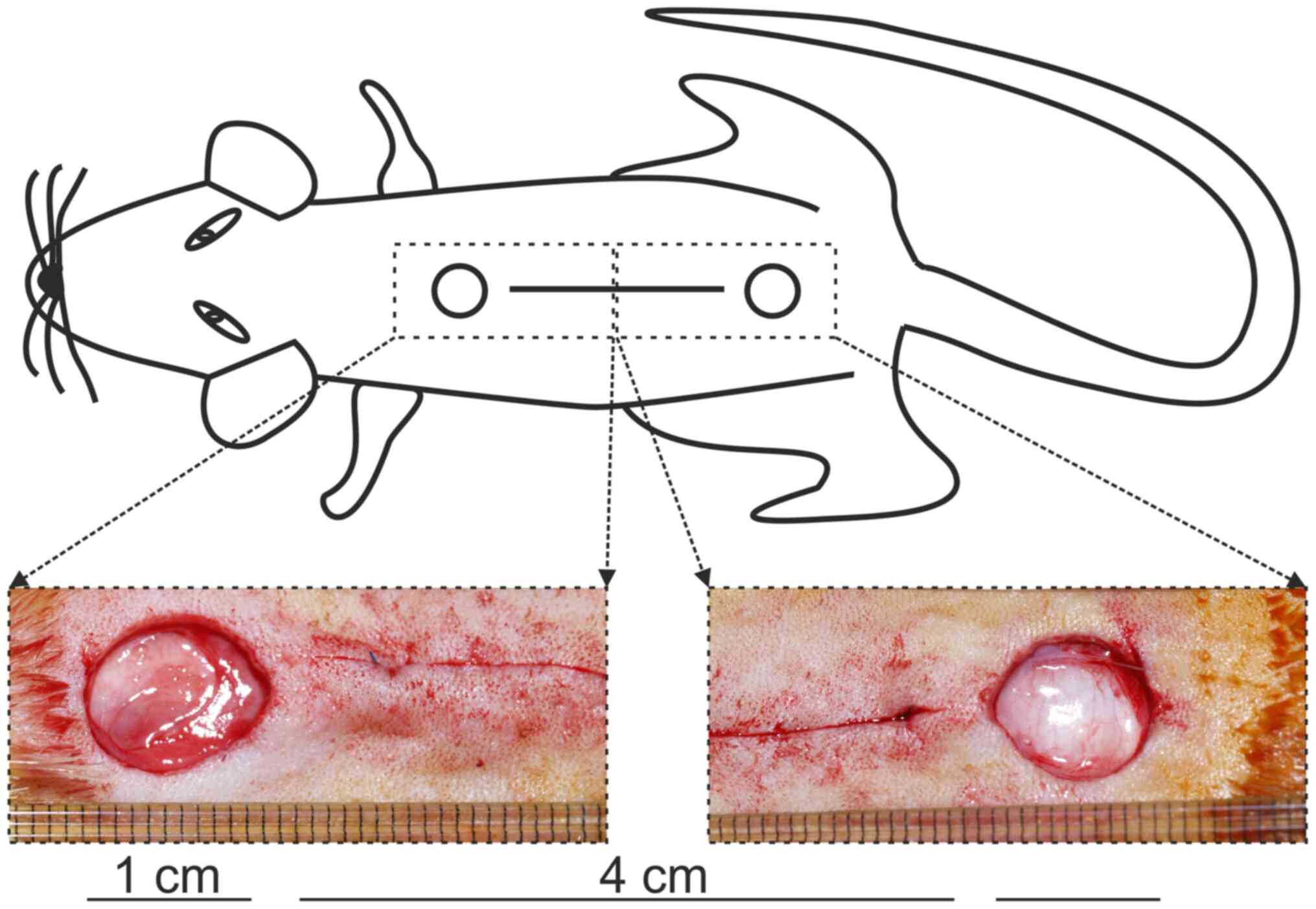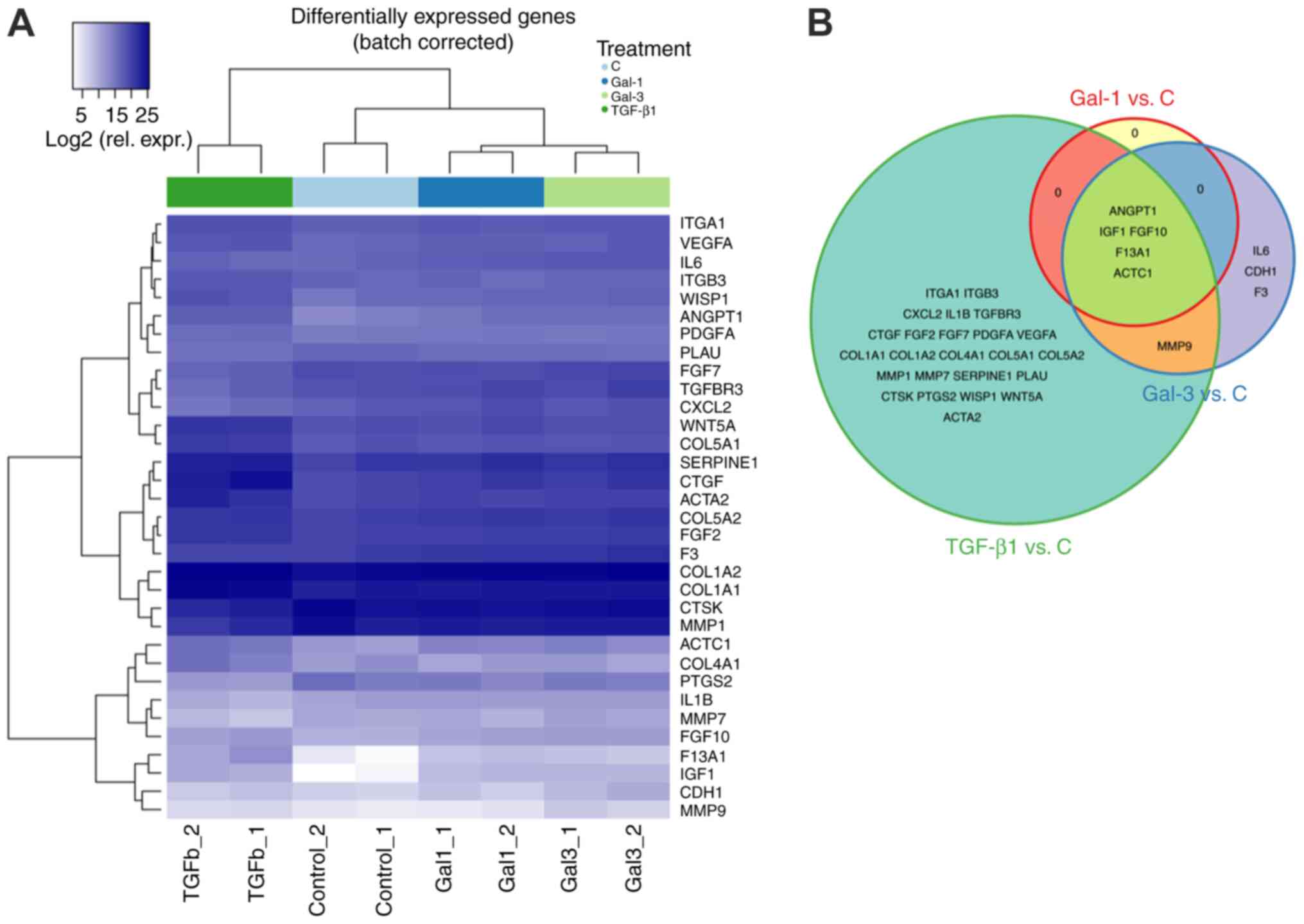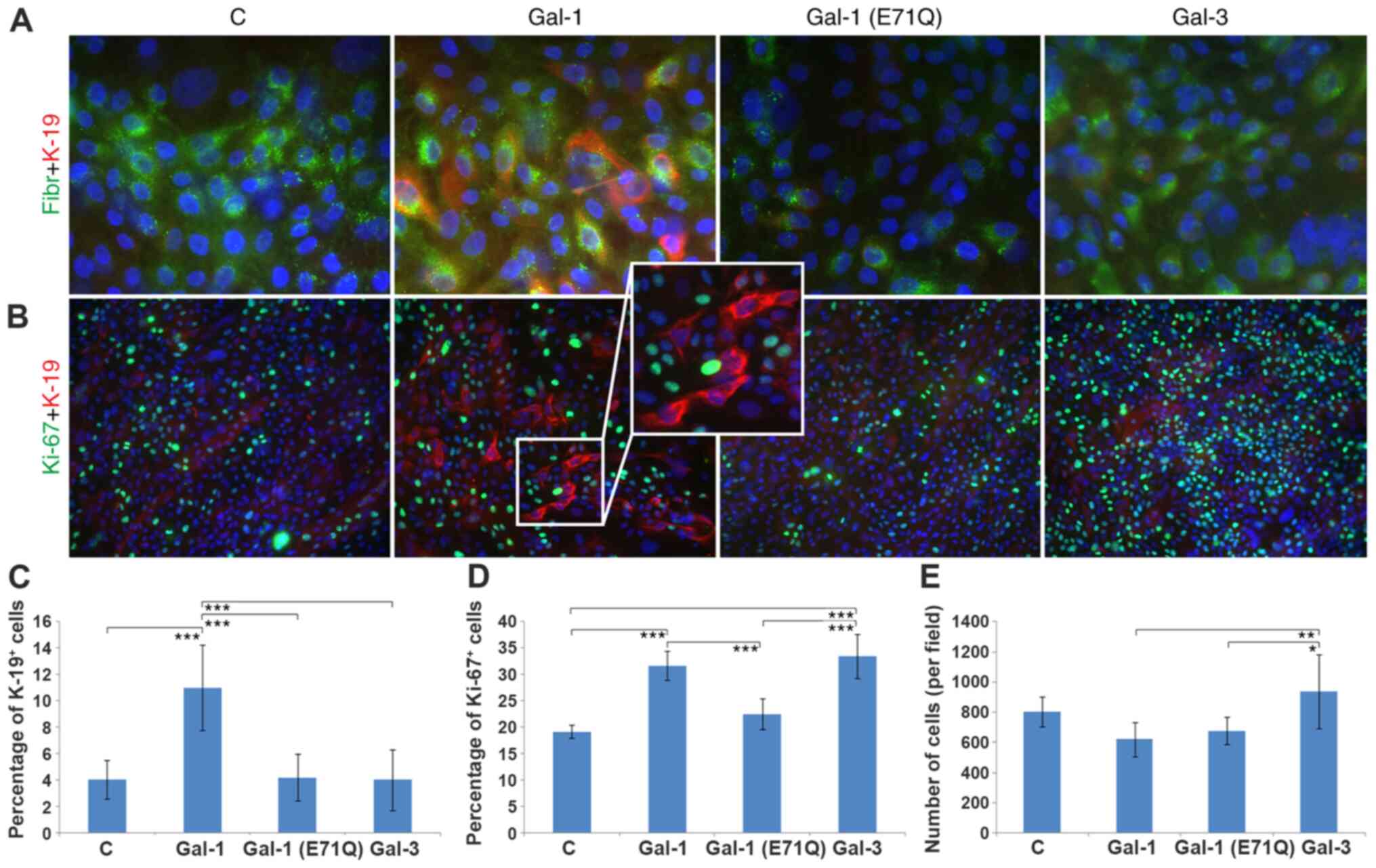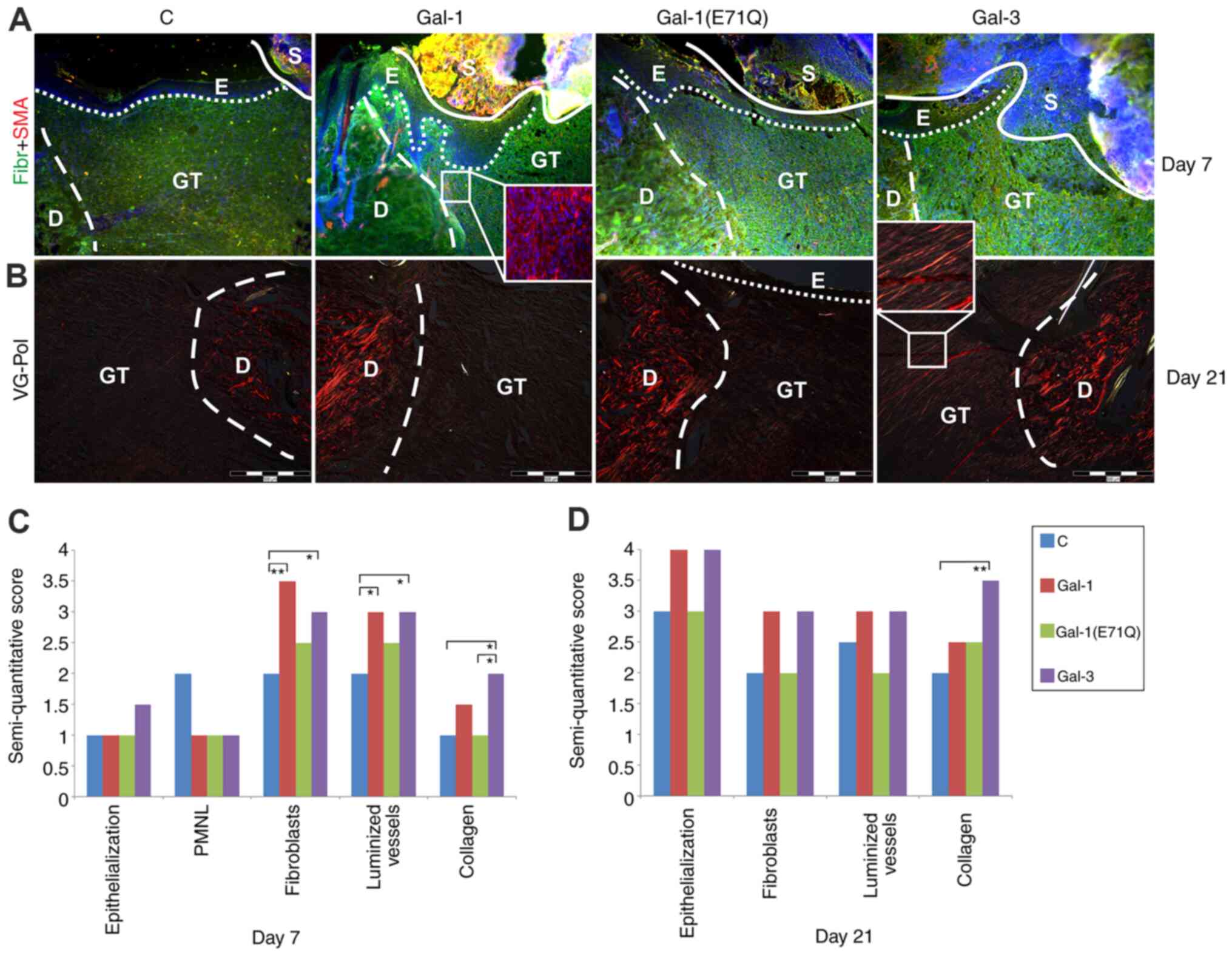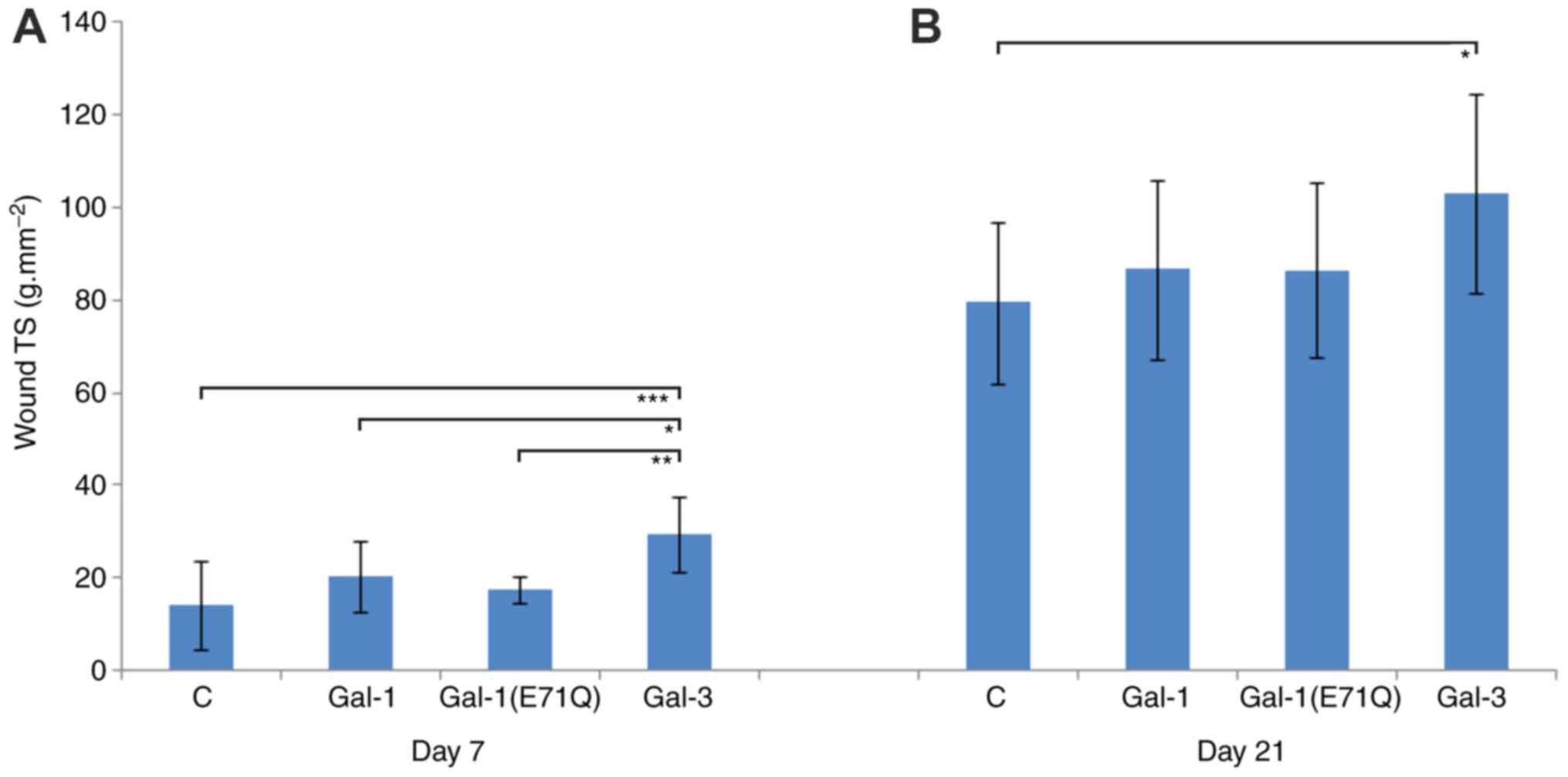|
1
|
Gaylarde PM and Sarkany I: Cell migration
and DNA synthesis in organ culture of human skin. Br J Dermatol.
92:375–380. 1975. View Article : Google Scholar
|
|
2
|
Donaldson DJ and Mason JM: Inhibition of
epidermal cell migration by concanavalin A in skin wounds of the
adult newt. J Exp Zool. 200:55–64. 1977. View Article : Google Scholar
|
|
3
|
Harrison FL and Chesterton CJ: Factors
mediating cell-cell recognition and adhesion. Galaptins, a recently
discovered class of bridging molecules. FEBS Lett. 122:157–165.
1980. View Article : Google Scholar
|
|
4
|
Barondes SH: Galectins: A personal
overview. Trends Glycosci Glycotechnol. 9:1–7. 1997. View Article : Google Scholar
|
|
5
|
Hughes RC: Secretion of the galectin
family of mammalian carbohydrate-binding proteins. Biochim Biophys
Acta. 1473:172–185. 1999. View Article : Google Scholar
|
|
6
|
Liu FT, Patterson RJ and Wang JL:
Intracellular functions of galectins. Biochim Biophys Acta.
1572:263–273. 2002. View Article : Google Scholar
|
|
7
|
Thiemann S and Baum LG: Galectins and
immune responses-just how do they do those things they do? Annu Rev
Immunol. 34:243–264. 2016. View Article : Google Scholar
|
|
8
|
Kaltner H, Toegel S, Caballero GG, Manning
JC, Ledeen RW and Gabius HJ: Galectins: Their network and roles in
immunity/tumor growth control. Histochem Cell Biol. 147:239–256.
2017. View Article : Google Scholar
|
|
9
|
Sato S: Cytosolic galectins and their
release and roles as carbohydrate-binding proteins in host-pathogen
interaction. Trends Glycosci Glycotechnol. 30:SE199–SE209. 2018.
View Article : Google Scholar
|
|
10
|
de Jong CGHM, Gabius HJ and Baron W: The
emerging role of galectins in (re)myelination and its potential for
developing new approaches to treat multiple sclerosis. Cell Mol
Life Sci. 77:1289–1317. 2020. View Article : Google Scholar
|
|
11
|
García Caballero G, Kaltner H, Kutzner TJ,
Ludwig AK, Manning JC, Schmidt S, Sinowatz F and Gabius HJ: How
galectins have become multifunctional proteins. Histol Histopathol.
35:509–539. 2020.
|
|
12
|
Kutzner TJ, Higuero AM, Süssmair M, Kopitz
J, Hingar M, Díez-Revuelta N, Caballero GG, Kaltner H, Lindner I,
Abad-Rodríguez J, et al: How presence of a signal peptide affects
human galectins-1 and −4: Clues to explain common absence of a
leader sequence among adhesion/growth-regulatory galectins. Biochim
Biophys Acta Gen Subj. 1864:1294492020. View Article : Google Scholar
|
|
13
|
Flotte TJ, Springer TA and Thorbecke GJ:
Dendritic cell and macrophage staining by monoclonal antibodies in
tissue sections and epidermal sheets. Am J Pathol. 111:112–124.
1983.
|
|
14
|
Roff CF, Rosevear PR, Wang JL and Barker
R: Identification of carbohydrate-binding proteins from mouse and
human fibroblasts. Biochem J. 211:625–629. 1983. View Article : Google Scholar
|
|
15
|
Cowles EA, Moutsatsos IK, Wang JL and
Anderson RL: Expression of carbohydrate binding protein 35 in human
fibroblasts: Comparisons between cells with different proliferative
capacities. Exp Gerontol. 24:577–585. 1989. View Article : Google Scholar
|
|
16
|
Wollenberg A, de la Salle H, Hanau D, Liu
FT and Bieber T: Human keratinocytes release the endogenous
beta-galactoside-binding soluble lectin immunoglobulin E
(IgE-binding protein) which binds to Langerhans cells where it
modulates their binding capacity for IgE glycoforms. J Exp Med.
178:777–785. 1993. View Article : Google Scholar
|
|
17
|
Konstantinov KN, Shames B, Izuno G and Liu
FT: Expression of epsilon BP, a beta-galactoside-binding soluble
lectin, in normal and neoplastic epidermis. Exp Dermatol. 3:9–16.
1994. View Article : Google Scholar
|
|
18
|
Holiková Z, Smetana K Jr, Bartunková J,
Dvoránková B, Kaltner H and Gabius HJ: Human epidermal langerhans
cells are selectively recognized by galectin-3 but not by
galectin-1. Folia Biol (Praha). 46:195–198. 2000.
|
|
19
|
Larsen L, Chen HY, Saegusa J and Liu FT:
Galectin-3 and the skin. J Dermatol Sci. 64:85–91. 2011. View Article : Google Scholar
|
|
20
|
Pepe D, Elliott CG, Forbes TL and Hamilton
DW: Detection of galectin-3 and localization of advanced glycation
end products (AGE) in human chronic skin wounds. Histol
Histopathol. 29:251–258. 2014.
|
|
21
|
Walker JT, Elliott CG, Forbes TL and
Hamilton DW: Genetic deletion of galectin-3 does not impair
full-thickness excisional skin healing. J Invest Dermatol.
136:1042–1050. 2016. View Article : Google Scholar
|
|
22
|
McLeod K, Walker JT and Hamilton DW:
Galectin-3 regulation of wound healing and fibrotic processes:
Insights for chronic skin wound therapeutics. J Cell Commun Signal.
12:281–287. 2018. View Article : Google Scholar
|
|
23
|
Wu NL and Liu FT: The expression and
function of galectins in skin physiology and pathology. Exp
Dermatol. 27:217–226. 2018. View Article : Google Scholar
|
|
24
|
Filer A, Bik M, Parsonage GN, Fitton J,
Trebilcock E, Howlett K, Cook M, Raza K, Simmons DL, Thomas AM, et
al: Galectin-3 induces a distinctive pattern of cytokine and
chemokine production in rheumatoid synovial fibroblasts via
selective signaling pathways. Arthritis Rheum. 60:1604–1614. 2009.
View Article : Google Scholar
|
|
25
|
Weinmann D, Schlangen K, André S, Schmidt
S, Walzer SM, Kubista B, Windhager R, Toegel S and Gabius HJ:
Galectin-3 induces a pro-degradative/inflammatory gene signature in
human chondrocytes, teaming up with galectin-1 in osteoarthritis
pathogenesis. Sci Rep. 6:391122016. View Article : Google Scholar
|
|
26
|
Weinmann D, Kenn M, Schmidt S, Schmidt K,
Walzer SM, Kubista B, Windhager R, Schreiner W, Toegel S and Gabius
HJ: Galectin-8 induces functional disease markers in human
osteoarthritis and cooperates with galectins-1 and −3. Cell Mol
Life Sci. 75:4187–4205. 2018. View Article : Google Scholar
|
|
27
|
Cada Z, Smetana K Jr, Lacina L, Plzáková
Z, Stork J, Kaltner H, Russwurm R, Lensch M, André S and Gabius HJ:
Immunohistochemical fingerprinting of the network of seven
adhesion/growth-regulatory lectins in human skin and detection of
distinct tumor-associated alterations. Folia Biol (Praha).
55:145–152. 2009.
|
|
28
|
Klíma J, Lacina L, Dvorankova B, Herrmann
D, Carnwath JW, Niemann H, Kaltner H, André S, Motlík J, Gabius HJ
and Smetana K Jr: Differential regulation of galectin
expression/reactivity during wound healing in porcine skin and in
cultures of epidermal cells with functional impact on migration.
Physiol Res. 58:873–884. 2009.
|
|
29
|
Gál P, Vasilenko T, Kostelniková M,
Jakubco J, Kovác I, Sabol F, André S, Kaltner H, Gabius HJ and
Smetana K Jr: Open wound healing in vivo: Monitoring binding and
presence of adhesion/growth-regulatory galectins in rat skin during
the course of complete re-epithelialization. Acta Histochem
Cytochem. 44:191–199. 2011. View Article : Google Scholar
|
|
30
|
Dvoránková B, Szabo P, Lacina L, Gal P,
Uhrova J, Zima T, Kaltner H, André S, Gabius HJ, Sykova E and
Smetana K Jr: Human galectins induce conversion of dermal
fibroblasts into myofibroblasts and production of extracellular
matrix: Potential application in tissue engineering and wound
repair. Cells Tissues Organs. 194:469–480. 2011. View Article : Google Scholar
|
|
31
|
Gabius HJ: Influence of type of linkage
and spacer on the interaction of beta-galactoside-binding proteins
with immobilized affinity ligands. Anal Biochem. 189:91–94. 1990.
View Article : Google Scholar
|
|
32
|
Sarter K, André S, Kaltner H, Lensch M,
Schulze C, Urbonaviciute V, Schett G, Herrmann M and Gabius HJ:
Detection and chromatographic removal of lipopolysaccharide in
preparations of multifunctional galectins. Biochem Biophys Res
Commun. 379:155–159. 2009. View Article : Google Scholar
|
|
33
|
Kopitz J, Vértesy S, André S, Fiedler S,
Schnölzer M and Gabius HJ: Human chimera-type galectin-3: Defining
the critical tail length for high-affinity glycoprotein/cell
surface binding and functional competition with galectin-1 in
neuroblastoma cell growth regulation. Biochimie. 104:90–99. 2014.
View Article : Google Scholar
|
|
34
|
García Caballero G, Kaltner H, Michalak M,
Shilova N, Yegres M, André S, Ludwig AK, Manning JC, Schmidt S,
Schnölzer M, et al: Chicken GRIFIN: A homodimeric member of the
galectin network with canonical properties and a unique expression
profile. Biochimie. 128-129:34–47. 2016. View Article : Google Scholar
|
|
35
|
Rheinwald JG and Green H: Serial
cultivation of strains of human epidermal keratinocytes: The
formation of keratinizing colonies from single cells. Cell.
6:331–343. 1975. View Article : Google Scholar
|
|
36
|
Livak KJ and Schmittgen TD: Analysis of
relative gene expression data using real-time quantitative PCR and
the 2(-Delta Delta C(T)) method. Methods. 25:402–408. 2001.
View Article : Google Scholar
|
|
37
|
Ritchie ME, Phipson B, Wu D, Hu Y, Law CW,
Shi W and Smyth GK: Limma powers differential expression analyses
for RNA-sequencing and microarray studies. Nucleic Acids Res.
43:e472015. View Article : Google Scholar
|
|
38
|
Perzelova V, Sabol F, Vasilenko T, Novotný
M, Kováč I, Slezák M, Ďurkáč J, Hollý M, Pilátová M, Szabo P, et
al: Pharmacological activation of estrogen receptors-α and -β
differentially modulates keratinocyte differentiation with
functional impact on wound healing. Int J Mol Med. 37:21–28. 2016.
View Article : Google Scholar
|
|
39
|
Kovac I, Melegova N, Coma M, Takáč P,
Kováčová K, Hollý M, Ďurkáč J, Urban L, Gurbáľová M, Švajdlenka E,
et al: Aesculus hippocastanum L. extract does not induce fibroblast
to myofibroblast conversion but increases extracellular matrix
production in vitro leading to increased wound tensile strength in
rats. Molecules. 25:19172020. View Article : Google Scholar
|
|
40
|
Kovac I, Durkac J, Holly M, Jakubčová K,
Peržeľová V, Mučaji P, Švajdlenka E, Sabol F, Legáth J, Belák J, et
al: Plantago lanceolata L. water extract induces transition of
fibroblasts into myofibroblasts and increases tensile strength of
healing skin wounds. J Pharm Pharmacol. 67:117–125. 2015.
View Article : Google Scholar
|
|
41
|
Sabol F, Vasilenko T, Novotny M, Tomori Z,
Bobrov N, Zivčák J, Hudák R and Gál P: Intradermal running suture
versus 3M™ Vetbond™ tissue adhesive for wound closure in rodents: A
biomechanical and histological study. Eur Surg Res. 45:321–326.
2010. View Article : Google Scholar
|
|
42
|
Gál P, Toporcer T, Vidinsky B, Hudak R,
Zivcak J and Sabo J: Simple interrupted percutaneous suture versus
intradermal running suture for wound tensile strength measurement
in rats: A technical note. Eur Surg Res. 43:61–65. 2009. View Article : Google Scholar
|
|
43
|
Koshizuka S, Kanazawa K, Kobayashi N,
Takazawa I, Waki Y, Shibusawa H and Shumiya S: The beneficial
effects of recombinant human insulin-like growth factor-I (IGF-I)
on wound healing in severely wounded senescent mice. Surg Today.
27:946–952. 1997. View Article : Google Scholar
|
|
44
|
Cho CH, Sung HK, Kim KT, Cheon HG, Oh GT,
Hong HJ, Yoo OJ and Koh GY: COMP-angiopoietin-1 promotes wound
healing through enhanced angiogenesis, lymphangiogenesis, and blood
flow in a diabetic mouse model. Proc Natl Acad Sci USA.
103:4946–4951. 2006. View Article : Google Scholar
|
|
45
|
Quirinia A and Viidik A: The effect of
recombinant basic fibroblast growth factor (bFGF) in fibrin
adhesive vehicle on the healing of ischaemic and normal incisional
skin wounds. Scand J Plast Reconstr Surg Hand Surg. 32:9–18. 1998.
View Article : Google Scholar
|
|
46
|
Toegel S, Weinmann D, André S, Walzer SM,
Bilban M, Schmidt S, Chiari C, Windhager R, Krall C, Bennani-Baiti
IM and Gabius HJ: Galectin-1 couples glycobiology to inflammation
in osteoarthritis through the activation of an NF-κB-regulated gene
network. J Immunol. 196:1910–1921. 2016. View Article : Google Scholar
|
|
47
|
Ochieng J, Fridman R, Nangia-Makker P,
Kleiner DE, Liotta LA, Stetler-Stevenson WG and Raz A: Galectin-3
is a novel substrate for human matrix metalloproteinases-2 and −9.
Biochemistry. 33:14109–14114. 1994. View Article : Google Scholar
|
|
48
|
Sundqvist M, Welin A, Elmwall J, Osla V,
Nilsson UJ, Leffler H, Bylund J and Karlsson A: Galectin-3 type-C
self-association on neutrophil surfaces: The carbohydrate
recognition domain regulates cell function. J Leukoc Biol.
103:341–353. 2018. View Article : Google Scholar
|
|
49
|
Advedissian T, Proux-Gillardeaux V, Nkosi
R, Peyret G, Nguyen T, Poirier F, Viguier M and Deshayes F:
E-cadherin dynamics is regulated by galectin-7 at epithelial cell
surface. Sci Rep. 7:170862017. View Article : Google Scholar
|
|
50
|
Kyriakides TR, Wulsin D, Skokos EA,
Fleckman P, Pirrone A, Shipley JM, Senior RM and Bornstein P: Mice
that lack matrix metalloproteinase-9 display delayed wound healing
associated with delayed reepithelization and disordered collagen
fibrillogenesis. Matrix Biol. 28:65–73. 2009. View Article : Google Scholar
|
|
51
|
Kim MH, Wu WH, Choi JH, Kim J, Jun JH, Ko
Y and Lee JH: Galectin-1 from conditioned medium of
three-dimensional culture of adipose-derived stem cells accelerates
migration and proliferation of human keratinocytes and fibroblasts.
Wound Repair Regen. 26 (Suppl 1):S9–S18. 2018. View Article : Google Scholar
|
|
52
|
Liu W, Hsu DK, Chen HY, Yang RY, Carraway
KL III, Isseroff RR and Liu FT: Galectin-3 regulates intracellular
trafficking of EGFR through Alix and promotes keratinocyte
migration. J Invest Dermatol. 132:2828–2837. 2012. View Article : Google Scholar
|
|
53
|
Kershenobich Stalnikowitz D and Weissbrod
AB: Liver fibrosis and inflammation. A review. Ann Hepatol.
2:159–163. 2003. View Article : Google Scholar
|
|
54
|
Kjaer M, Langberg H, Heinemeier K, Bayer
ML, Hansen M, Holm L, Doessing S, Kongsgaard M, Krogsgaard MR and
Magnusson SP: From mechanical loading to collagen synthesis,
structural changes and function in human tendon. Scand J Med Sci
Sports. 19:500–510. 2009. View Article : Google Scholar
|
|
55
|
Kjaer M, Magnusson P, Krogsgaard M, Boysen
Møller J, Olesen J, Heinemeier K, Hansen M, Haraldsson B, Koskinen
S, Esmarck B and Langberg H: Extracellular matrix adaptation of
tendon and skeletal muscle to exercise. J Anat. 208:445–450. 2006.
View Article : Google Scholar
|
|
56
|
Pena E, de la Torre R, Arderiu G, Slevin M
and Badimon L: mCRP triggers angiogenesis by inducing F3
transcription and TF signalling in microvascular endothelial cells.
Thromb Haemost. 117:357–370. 2017. View Article : Google Scholar
|
|
57
|
Kopitz J, von Reitzenstein C, André S,
Kaltner H, Uhl J, Ehemann V, Cantz M and Gabius HJ: Negative
regulation of neuroblastoma cell growth by carbohydrate-dependent
surface binding of galectin-1 and functional divergence from
galectin-3. J Biol Chem. 276:35917–35923. 2001. View Article : Google Scholar
|
|
58
|
Manning JC, García Caballero G, Knospe C,
Kaltner H and Gabius HJ: Network analysis of
adhesion/growth-regulatory galectins and their binding sites in
adult chicken retina and choroid. J Anat. 231:23–37. 2017.
View Article : Google Scholar
|
|
59
|
García Caballero G, Schmidt S, Schnölzer
M, Schlötzer-Schrehardt U, Knospe C, Ludwig AK, Manning JC,
Muschler P, Kaltner H, Kopitz J and Gabius HJ: Chicken GRIFIN:
Binding partners, developmental course of localization and
activation of its lens-specific gene expression by L-Maf/Pax6. Cell
Tissue Res. 375:665–683. 2019. View Article : Google Scholar
|
|
60
|
García Caballero G, Schmidt S, Manning JC,
Michalak M, Schlötzer-Schrehardt U, Ludwig AK, Kaltner H, Sinowatz
F, Schnölzer M, Kopitz J and Gabius HJ: Chicken lens development:
Complete signature of expression of galectins during embryogenesis
and evidence for their complex formation with α-, β-, δ- and
τ-crystallins, N-CAM, and N-cadherin obtained by affinity
chromatography. Cell Tissue Res. 379:13–35. 2020. View Article : Google Scholar
|
|
61
|
Gabius HJ: How to crack the sugar code.
Folia Biol (Praha). 63:121–131. 2017.
|
|
62
|
Kopitz J, Xiao Q, Ludwig AK, Romero A,
Michalak M, Sherman SE, Zhou X, Dazen C, Vértesy S, Kaltner H, et
al: Reaction of a programmable glycan presentation of
glycodendrimersomes and cells with engineered human lectins to show
the sugar functionality of the cell surface. Angew Chem Int Ed
Engl. 56:14677–14681. 2017. View Article : Google Scholar
|
|
63
|
Ludwig AK, Michalak M, Xiao Q, Gilles U,
Medrano FJ, Ma H, FitzGerald FG, Hasley WD, Melendez-Davila A, Liu
M, et al: Design-functionality relationships for
adhesion/growth-regulatory galectins. Proc Natl Acad Sci USA.
116:2837–2842. 2019. View Article : Google Scholar
|
|
64
|
Ludwig AK, Kaltner H, Kopitz J and Gabius
HJ: Lectinology 4.0: Altering modular (ga)lectin display for
functional analysis and biomedical applications. Biochim Biophys
Acta Gen Subj. 1863:935–940. 2019. View Article : Google Scholar
|
|
65
|
Stone RC, Pastar I, Ojeh N, Chen V, Liu S,
Garzon KI and Tomic-Canic M: Epithelial-mesenchymal transition in
tissue repair and fibrosis. Cell Tissue Res. 365:495–506. 2016.
View Article : Google Scholar
|
|
66
|
Haensel D and Dai X:
Epithelial-to-mesenchymal transition in cutaneous wound healing:
Where we are and where we are heading. Dev Dyn. 247:473–480. 2018.
View Article : Google Scholar
|
|
67
|
Smetana K Jr, André S, Kaltner H, Kopitz J
and Gabius HJ: Context-dependent multifunctionality of galectin-1:
A challenge for defining the lectin as therapeutic target. Expert
Opin Ther Targets. 17:379–392. 2013. View Article : Google Scholar
|
|
68
|
Romero A and Gabius HJ: Galectin-3: Is
this member of a large family of multifunctional lectins (already)
a therapeutic target? Expert Opin Ther Targets. 23:819–828. 2019.
View Article : Google Scholar
|















